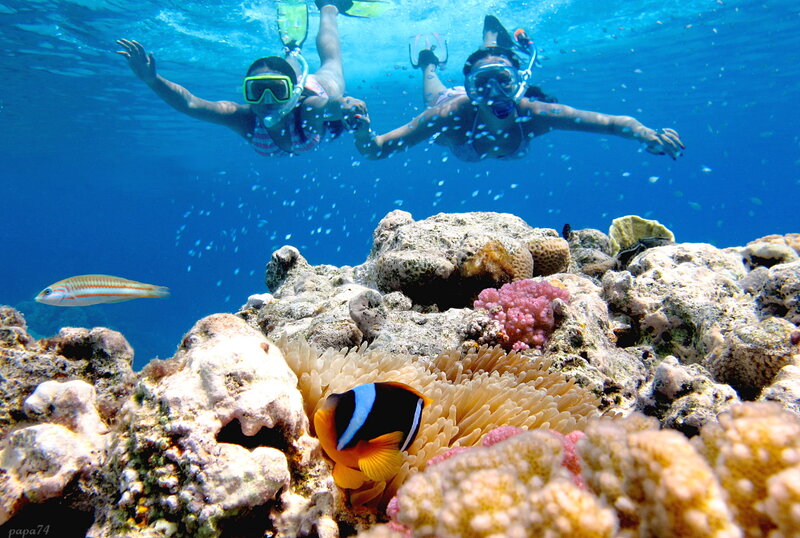


Fish-urchin - Porcupinefishes (Diodontidae) Dlinnoshipaya fish hedgehog Spot-fin porcupinefish Diodon hystrix their short terete body can swell up like a blowfish. Jaw teeth fused into beak plates without cross seam, so the upper and lower jaws is one tooth (diodon in Latin means "bidentate"). The scales on the body transformed into thorns, sometimes quite long, which in the quiescent state close to the body, while inflating the fish are raised vertically. Small dorsal and anal fins lack spines, and shifted to the tail.Pelvic fins are absent. The majority of these fish are mid-sized, but some species can reach one meter in length.

Dvulineyny Cardinal. Two-lined cardinalfish Archamia bilineata (Apogonidae)

Titan triggerfish, Red Sea, Egypt. Titan triggerfish. Balistoides viridescens (Balistidae) up to 75 cm male guards his clutch Titanium triggerfish even dangerous for divers - its massive teeth clearly hints at this.Each jaw carries eight powerful incisors in the upper jaw and they have strengthened the second row of six dental plates. If we consider that the dental apparatus is driven by powerful muscles of the lower jaw, it becomes clear why triggerfish easy to crack the thick shells of mollusks, coral branches and crushed shells of sea urchins and crabs. One of the favorite food items triggerfish - sea urchins. If triggerfish senses danger, it hides in coral crevice where spreads dorsal thorn latch and abdominal spike, so pull it becomes completely impossible. Normally triggerfish swim by undulating movements of dorsal and anal fins.

Dusky stegastes. Dusky farmerfish Stegastes nigricans (Pomacentridae)

Starfish in the Red Sea, it only occurs in the Red Sea. It prefers shallow depths.


Royal angelfish Pygoplites diacanthus Royal angelfish



Pennant butterflyfish Red sea bannerfish armor. Heniochus intermedius At sea bannerfish high flat body with an elongated snout spotty small and elongated fourth ray of the dorsal fin, forming a characteristic "pennant", the size of which depends on the species.

Giant moray Giant moray Gymnothorax javanicus (Muraenidae)


Zebrovidny dastsill or Trehpolosy dastsill. Whitetail dascyllus Dascyllus aruanus (Pomacentridae) Zebrovidny dastsill length of 6.5 cm. High, white body, there are three broad black lateral stripe extending from the base of the dorsal fin to the head through the throat from the middle of the dorsal fin to the ventral fin and black on the back of the spinal cord fin to anal fin. The caudal fin white. Fish live in large flocks in the coral genus Acropora or smaller groups on isolated coral outside the main reef. They feed on zooplankton, small benthic invertebrates, and algae.

Titan triggerfish and Oranzhevopery Triggerfishes
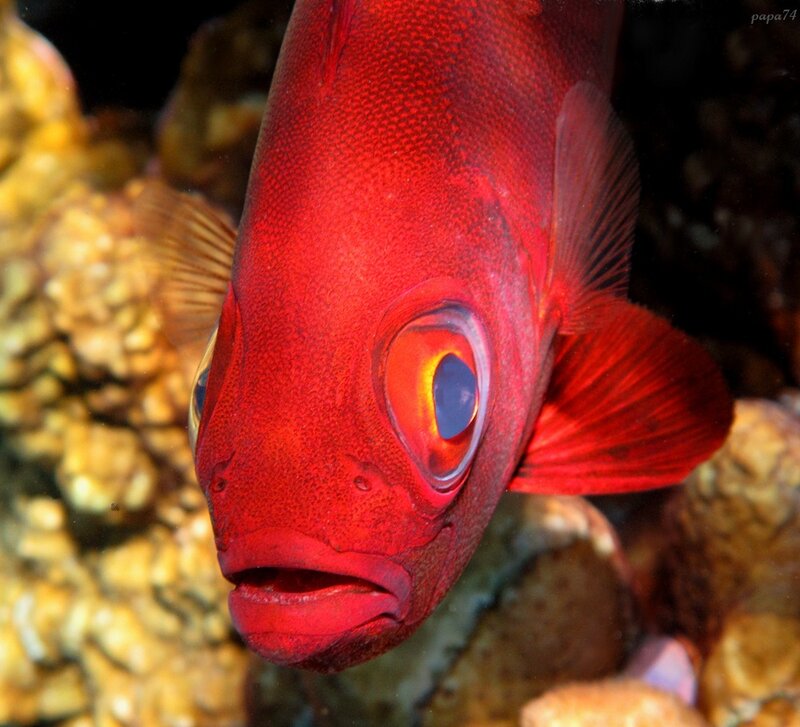
Paeony-hamrur Crescend-tail bigeye


Striped butterflyfish Diagonal-lined butterflyfish Chaetodon fasciatus

Nudibranchs. They are reminiscent of garden slugs, but are whimsical and brightly colored growths.Almost all of them, if not beautiful, it is elegant. Unlike other mollusks have no shell, but that does not mean that animals are vulnerable to enemies: their body is covered with unpleasant mucus and the skin contains numerous glands secreting poisonous substances, scaring predators. Bright and extravagant coloring as if warns of the presence of such a chemical protection. The economic activity of man, these animals do not play any role, but the meeting with them under water brings aesthetic pleasure. Spanish dancer Spanish dancer Hexabranchus sanguineus (Rüppell & Leuckart, 1828) (Hexabranchidae) The largest nudibranch, reaching half-meter length. His name was of a bright red color with a white body. It feeds on a variety of sponges, from whom receives a poisonous substance, making it inedible to predators.


Amfipriony Red Sea in its natural habitat Red Sea, Egypt

Red Sea, Naama Bay, Sharm El Sheikh, Egypt

Brown fish knife Novaculichthys taeniourus Rockmover wrasse

Photographed in natural habitat. Red Sea, Egypt Sea anemones or sea anemones (lat. Actiniaria) - detachment from the class of marine Cnidaria coral polyps (Anthozoa). Representatives deprived mineral skeleton. Clown fish, or amfipriony (lat. Amphiprion) - genus of marine fishes of the family pomacentridae. Little Indo-Pacific fish genus Amphiprion (clown fish) live among the tentacles of large sea anemones, entering the latest in a symbiotic relationship. Anemones "recruit" young fish, highlighting attract their agents (attractants). The attractants are species-specific, ie only attract a certain type of organisms. Covering fish mucus does not contain substances that trigger Popping nematocysts so they can exist between the tentacles of sea anemones in the deadly habitat for other animals. Sea anemone fishes provides protection and food debris and fish are attracted to the "owner" prey (fish of other species), protect it from certain predators (butterfly fish), remove necrotic tissue and swimming among the tentacles, "aired" actin, preventing silt contamination.



Kudrepёr Forster Paracirrhites forsteri Blackside hawkfish
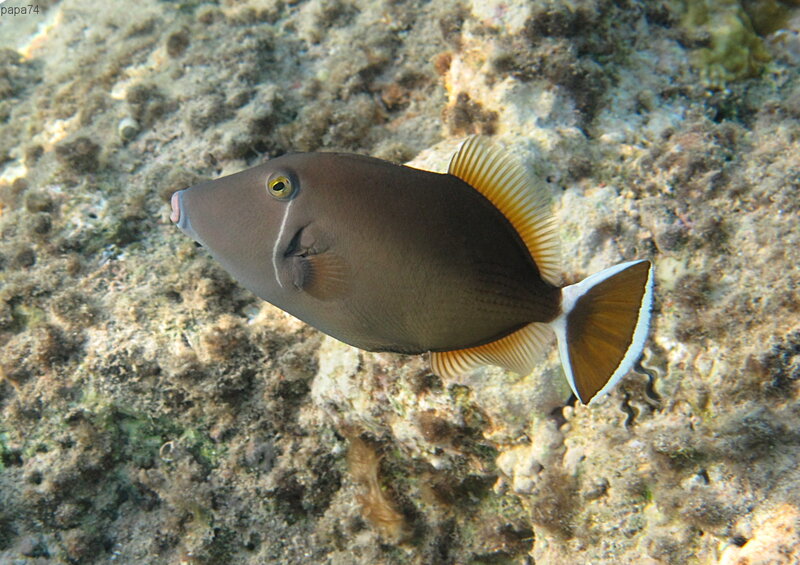
White-tailed triggerfish Bluethroat triggerfish Sufflamen albicaudatum (Balistidae)

Egypt Red Sea

Kudrepёr Forster Blackside hawkfish Paracirrhites forsteri (Cirrhitidae)


Red sea bannerfish Heniochus intermedius Red sea bannerfish Red sea bannerfish one of the most famous inhabitants of the coral reefs of the Red Sea from the family of butterfly fish. Color body white and yellow, silver-gray head, in my eyes and in the back part of the body are two curves of longitudinal stripes of black. The body is laterally flattened, high. The front of the dorsal fin has a long arm. Most often swim in pairs or small groups, at depths ranging from 4 to 50 meters at the outer reef slope and sandy bottom. There are many reefs on the warm Red Sea Sinai Peninsula, where we saw her at Coral Island to Eritrea, also observed in the Gulf of Aden and off the coast of Africa.
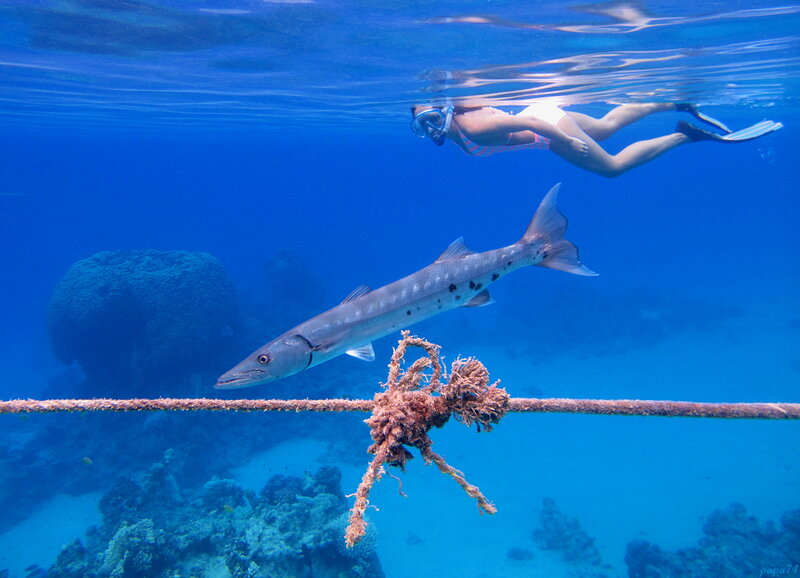
Barracuda

The sea urchin - a hat Pastor Parson's hat sea urchin Tripneustes gratilla (Toxopneustidae) Proper sea urchins the size of a large orange. Distributed throughout the Indo-Pacific. Various coloration, more often bright individuals with five double red stripes meridian. Usually in the sea grass, but it is difficult to notice them, since animals are masked with pieces of seaweed, fragments of shells and coral. It feeds on algae and sea grass. The needles are sharp and fairly long. The main danger to humans are toxic peditsillyarii.


Redbanded grouper Red banded grouper Epinephelus fasciatus (Serranidae) These small groupers are sometimes yellow or brick-red color with no vertical stripes, but most often on the trunk they are viewed 5 wide dark vertical stripes, which are best visible at the base of the dorsal fin. The hallmark of these groupers - noticeable black triangular spot behind the top of each hard ray of the dorsal fin. Eyes with narrow black rim. They live from the Red Sea and eastern Africa to the Central Pacific. The usual view of coral reefs and rocky coastal. It is found from shallow water to a depth of 160 m. Consumes crustaceans (crab, shrimp), mollusks and fish fry. It uses the local fishery.

LIONFISH red lionfish has a bright motley color body with brownish-red, black and white stripes. Caudal, anal and rear dorsal fin transparent and covered with black or white dots. This expressive painting red lionfish warns others of the presence of poisonous needles and helps to mask in raznotsvete coral reefs.

This small mobile vysokotelye fish with a short head, big eyes and a small mouth. There are in all tropical seas. On coral reefs is - one of the largest groups of fish both in species composition and abundance.On the reefs inhabit all oceans of about 300 species of fish pomacentridae. Blue-green chromis Blue-green chromis Chromis viridis (Pomacentridae)

Oranzhevopery triggerfish Orangelined triggerfish Balistapus undulatus (Balistidae)

Royal Angelfish Royal angelfish Pygoplites diacanthus, Pomacanthidae the yellow body are wide vertical blue and white stripes with a dark edge. On the dorsal fin, these bands are bent back. The back of the dorsal fin dark blue, with a lot of dots. Anal fin yellow-orange with a 5-6 blue lines running parallel to the contour of the body. Eye masked wide dark blue stripe with blue edges, which runs from the nape. The edge of the gill cover bright blue with a large spike.

Masked puffer Masked puffer Arothron diadematus (Tetraodontidae) Masked puffer fish found only in the Red Sea, which usually occurs more often divers and divers other kinds of family blowfish. Distributed in the north sea on the reefs of Eilat, and in the south up to Djibouti. Despite the fact that the fish are active at night, for her can be seen in the daytime, when she swims in the lagoon or on the outer slope of the reef at a depth of 3 to 30 meters. Arothron diadematus has a funny look. Body large, elongated tail, and fins are small. The body has various white beige and light brown spots along the strip of brown eye passes, because of which the fish got its name. White Tail fins are dark brown. As four sharp teeth protrude plates, two of which are fused to the upper part of the mouth, and the other two on the underside. This powerful weapons Blowfish helps to split the shells of mollusks, and bite hard substrate such as coral. Also, this is an interesting fish feeds on sponges and algae.

Korotkoryly pentapod Humpnose big-eye bream Monotaxis grandoculis - Lethrinidae letrinovyh Fish of the family, grows up to 60 cm, in the afternoon resting in small flocks. Careful not to keep away divers and photographers. Fry with three dark stripes on the back.

Striped lionfish has several names: zebra fish, lionfish, red lionfish. It is compared with a zebra because striped coloring, consisting of gray, red and brown stripes; lion - because of the long veeropodobnyh fins that give the fish the appearance of a kind of "mane". Samara is her nickname because of the large pectoral fins resembling wings.


Sergeants pomacentridae fish - Damselfishes Uzkopolosy abudefduf Indo-pacific sergeant Abudefduf vaigiensis (Pomacentridae) Boca and tail of silvery fish, back yellowish, gray head. On the sides of five vertical black stripes. During the mating season, and in the protection of calves males are blue. The Red Sea is found everywhere. It was recently discovered in the Mediterranean Sea. Typically, these fish form large accumulations at a shallow depth at the edge of the reef. Very curious fish, divers are not afraid.


Triggerfish - Triggerfishes psevdobalist Blue Blue-and-gold triggerfish Pseudobalistes fuscus (Balistidae)

Hotel Grand Rotana Egypt, Sinai Peninsula

Medusa - True Jellyfishes Saucer jelly Aurelia aurita (Linnaeus, 1758) (Ulmaridae) Aurelia lives in all tropical and subtropical seas in both hemispheres, and even comes in the Arctic zone. Most forms massive clusters. Flattened translucent dome separate instances can reach 40 cm in diameter. Aurelia is easily recognized by pinkish or purple horseshoes and four dark in the central part of the dome - gonads.Along the edges of the dome at the center of the mouth are four long oral lobes resembling donkey ears - hence the name. Screech jellyfish - a bad swimmer: reducing the dome, it can slowly rise to the surface and then dive into the depths. On the dome has eight rhopalium bearing eyes and statocysts.They allow jellyfish to keep some distance from the surface where the waves would break her tender body. Food fish fry jellyfish are pelagic crustaceans, pelagic larvae of sea squirts and other invertebrates. Nutritive particles are trapped in the tentacles and mouth opening act, and from there into the digestive cavity. In some countries in South-East Asia they eat.


Red Sea amfiprion

Painted aluter Scrawled filefish Aluterus scriptus (Osbeck, 1765) (Monacanthidae) have painted alutera the first ray of the dorsal fin, very thin and delicate, it is located directly above the eye. The elongated snout with a noticeable concavity. Quite a large tail fin rounded. The basic tone color from olive-brown to gray or rusty with blue lines and spots. Juveniles yellowish-brown with a dark pattern. This is the biggest unicorn, reaches a length of 110 cm. It is found in tropical, subtropical and warm temperate waters of all oceans. It lives on the outside, and on the slope of the reef lagoon, as well as among the thickets of vegetation. Despite the large size, well masked. Sometimes it drops to a depth of 120 meters. Keeps alone. View omnivorous - consumes as vegetation and a variety of invertebrates, including gorgonians, colonial anemones and tunicates. Breeding has not been investigated in detail. It is known that the bottom lays eggs and larvae live a long time in the water column. Young fish are often held among floating algae, including Sargassum. There are reports that the meat of this fish caused ciguatera. (Lyricist - Smirnov SA)

Napoleon Cheilinus undulatus Napoleon wrasse



Fairy psevdantias or Lyrebird (blue-eyed) Anthias Pseudanthias squamipinnis (Serranidae)

Fairy psevdantias or Lyrebird (blue-eyed) Anthias Pseudanthias squamipinnis (Serranidae) Females eyed Antias reach 7 cm in length, their body is yellow or orange, they have characteristic stripes from the eyes to the side fins.
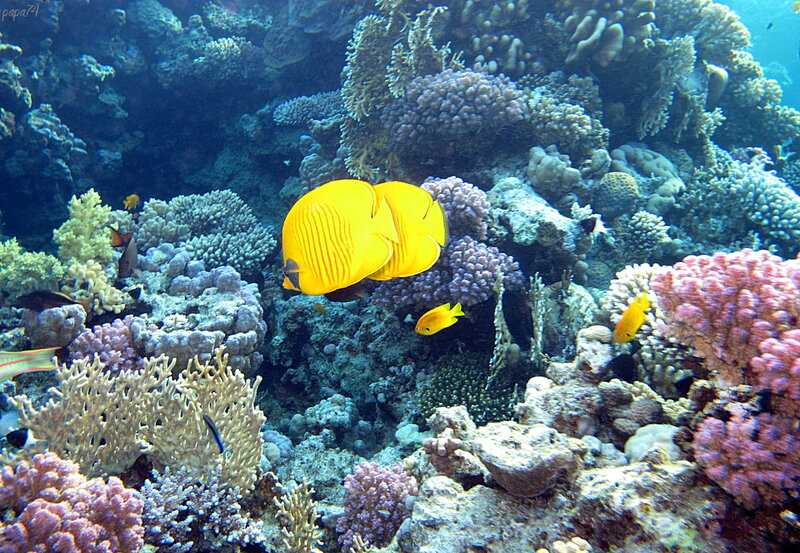
Masked butterflyfish Bluecheek butterflyfish Chaetodon semilarvatus

Butterflyfish masked (Masked butterflyfish) Bluecheek butterflyfish Chaetodon semilarvatus

Hawksbill turtle Hawksbill sea turtle Eretmochelys imbricata - Cheloniidae

Painted aluter Scrawled filefish Aluterus scriptus - Monacanthidae alutera have painted the first ray of the dorsal fin, very thin and delicate, it is located directly above the eye. The elongated snout with a noticeable concavity. Quite a large tail fin rounded. The basic tone color from olive-brown to gray or rusty with blue lines and spots. Juveniles yellowish-brown with a dark pattern. This is the biggest unicorn, reaches a length of 110 cm. It is found in tropical, subtropical and warm temperate waters of all oceans. It lives on the outside, and on the slope of the reef lagoon, as well as among the thickets of vegetation. Despite the large size, well masked. Sometimes it drops to a depth of 120 meters. Keeps alone. View omnivorous - consumes as vegetation and a variety of invertebrates, including gorgonians, colonial anemones and tunicates. Breeding has not been investigated in detail. It is known that the bottom lays eggs and larvae live a long time in the water column. Young fish are often held among floating algae, including Sargassum. There are reports that the meat of this fish caused ciguatera.(Lyricist - Smirnov SA)

Zhёltopyatnistaya angelfish (synonyms: False Asfour, Angel crescent Makulozus) Yellowbar angelfish or Purplemoon (Blue moon) angel Pomacanthus maculosus - Pomacanthidae




Yu.Sinay Red Sea, Sharm El Sheikh Naama Bay

No comments:
Post a Comment